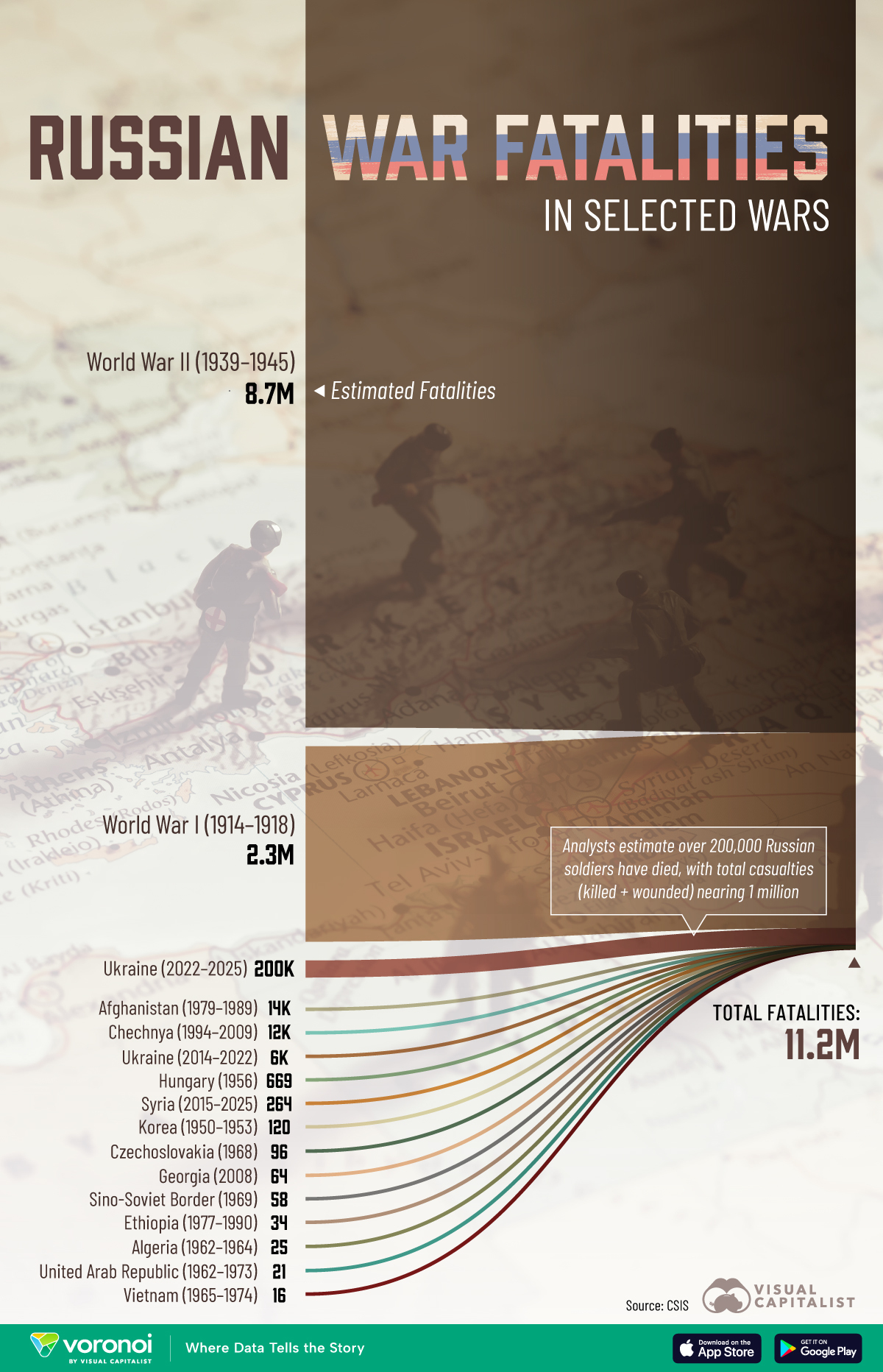![]()
See this visualization first on the Voronoi app.

Use This Visualization
Charted: Ukraine Is Russia’s Third Deadliest War
This was originally posted on our Voronoi app. Download the app for free on iOS or Android and discover incredible data-driven charts from a variety of trusted sources.
Key Takeaways
- The full-scale invasion of Ukraine has become Russia’s third deadliest conflict, trailing only the two world wars in lives lost.
- Russian fatalities in Ukraine already dwarf those from Soviet-era interventions such as Afghanistan, Chechnya, and Hungary.
This chart ranks estimated Russian fatalities in selected wars, showing where the current invasion of Ukraine fits in historical context. It highlights that today’s fighting has eclipsed every Russian war since 1945 in combat deaths—and the numbers are still climbing.
The data for this visualization comes from the Center for Strategic and International Studies (CSIS). CSIS estimates that between 200,000 and 250,000 Russian soldiers have been killed in Ukraine since February 2022, with total casualties—killed and wounded—approaching one million.
That puts the war behind only World War II (8.7 million Russian deaths) and World War I (2.3 million) in the table of Russian military losses. Because hostilities remain active, the final toll could rise even further.
| War | Time | Estimated Fatalities |
|---|---|---|
| World War II | 1939–1945 | 8.7M |
| World War I | 1914–1918 | 2.3M |
| Ukraine | 2022–2025 | 200K |
| Afghanistan | 1979–1989 | 14K |
| Chechnya | 1994–1996, 1999–2009 | 12K |
| Ukraine | 2014–2022 | 6K |
| Hungary | 1956 | 669 |
| Syria | 2015-2025 | 264 |
| Korea | 1950–1953 | 120 |
| Czechoslovakia | 1968 | 96 |
| Georgia | 2008 | 64 |
| Sino-Soviet Conflict | 1969 | 58 |
| Ethiopia | 1977–1990 | 34 |
| Algeria | 1962–1964 | 25 |
| United Arab Republic | 1962–1973 | 21 |
| Vietnam | 1965–1974 | 16 |
Soviet-Era Interventions Pale in Comparison
Russia’s modern wars typically produced far fewer fatalities: the decade-long occupation of Afghanistan caused an estimated 14,000 troop deaths, while campaigns in Chechnya resulted in roughly 12,000. According to RAND, those conflicts strained the Soviet and Russian militaries but never scaled to the mass-mobilization levels seen today.
Mobilization Drives Domestic Discontent
High casualty rates have fueled public dissatisfaction at home. As Levada Center polling shows, support for prolonged fighting drops sharply among families with draft-aged sons. Meanwhile, reports compiled by Meduza suggest that payouts to soldiers’ families often lag behind official promises, amplifying anger in rural regions that supply a disproportionate share of recruits.
Ukraine’s Losses Are Also Heavy
The Ukrainian government estimates between 60,000 and 100,000 military deaths since 2022. While lower than Russia’s, these figures are devastating for a country with a population one-third the size of Russia’s.
Learn More on the Voronoi App ![]()
If you enjoyed today’s post, check out What $175B in War Damage Looks Like in Ukraine on Voronoi, the new app from Visual Capitalist.